When we behold a beautiful historic house of worship, we may well find a sturdy and durable congregation that has also withstood the test of time. Both materials and people become a study in resilience. Redeemer Lutheran Church in Kingston is a sweet and brightly warm church set within the Rondout neighborhood of this Hudson Valley city. Its marble and limestone are excavated from rocks that are millions of years old. Those who designed and built the church a century ago chose the marble and limestone, among other reasons, for their magnificence, strength, and ability to last. The materials that are part of the geologic time scale become entwined with the time that humans keep, in years, decades, and centuries.
Kingston has many historic churches and temples, and Redeemer is one of its seemingly hidden gems. At 104 Wurts St., it is back in a residential section off the main avenues. From an approach walking south along Wurts Street, Redeemer Lutheran looks like it could be set in a town in the English countryside. Its light gray stone with beige trim gives an impression of stately simplicity. It represented one of the early 20th century Gothic Revival churches that broke from the more ostentatious mold of the Victorian era.
Redeemer Lutheran Church
In an important sense, breaking from the past matched the ethic of those who built this church. They were a new generation of Americans of German heritage who had been part of a nearby German-language Lutheran church that immigrants established in the mid-19th century, Trinity Evangelical Lutheran Church, located several blocks away on Spring Street. Their ancestors had emigrated during difficult times in Germany and had settled in Rondout, founding a church that provided services in their native language.
The younger generation wanted to worship in English. In 1897, a group of these congregation members founded Redeemer Lutheran – its formal name was the English Evangelical Lutheran Church of the Redeemer – and a century ago constructed their own church. Since then, it has been a peaceful refuge for its members through times of war and peace, prosperity and depression, and neighborhood neglect and revitalization. Imagine worshippers, subsequent generations of families, seated beneath the Good Shepherd window, decade after decade.
Architects From Brooklyn
The architecture neatly fit with this new English-speaking generation that started the congregation, a very English kind of church in its interpretation of Gothic. William Bannister and Richard Schell were the architects. Practicing in Brooklyn, Bannister and Schell designed a number of Lutheran churches, including St. Luke’s in Woodlawn, Queens, according to William Rhoads in his book, Kingston, New York: The Architectural Guide. Among the Gothic Revival-designed churches in Kingston, Redeemer Lutheran “is the closest to the designs of the leading Gothic Revivalists of the early 20th century, Ralph Adams Cram and Bertram Goodhue,” Rhoads writes.
Redeemer Lutheran is distinct from the Victorian-era churches in its lower proportions and light-colored stone, as Rhoads explains. The light gray stone is St. Lawrence marble, a rough-hewn rock popular in the 19th and early 20th centuries which workers mined from quarries in upstate New York. The marble is trimmed with beige Indiana limestone.
In its design, materials, and details, the structure has the feeling of a Gothic-style village church. It has a lower-height single tower and consistent Gothic details, from its steep-pitched roof and the interior ribbed vaults to the clerestory windows (the level placed high above the eye level, allowing in greater light). The church has a sense of majesty even in a relatively compact structure. Sometimes Gothic interiors can feel overwhelming, but this one is welcoming and charming.
The interior of Redeemer Lutheran Church
Next year will mark 100 years since the congregation placed the cornerstone for the church’s construction. It has survived as a house of worship and a place of beauty in the neighborhood, and that’s no accident. “We work hard to take care of this church,” says Patty Wolff, parish administrator. Indeed, it has the atmosphere of a well-tended home.
Tribulations and Triumphs
That a church’s flock also has proven resilient for those 100 years – and 114 years since the congregation’s founding – means it has had to survive the flowing tides of good fortune and difficult loss and trials. The first years after the congregation settled into its new church were tinged by the shadow of World War I engulfing Europe and ultimately drawing in the United States. Of 46 Redeemer Lutheran members who fought in the war, three church members lost their lives.
The church sometimes had financial difficulties as well. In June, 1927, church members discovered that under Pastor William Nelson, Redeemer Lutheran’s fourth pastor, the church had no money to pay salaries for the month. The minister refused to produce the Congregational Record, a church historical booklet notes, and subsequently he resigned.
With new leadership, however, Redeemer Lutheran endured and even thrived, despite the Great Depression enveloping the area and nation. The minister who accepted the call in 1927 to lead Redeemer Lutheran, the Rev. Oscar Brandorff, guided the congregation back to financial health and helped restore goodwill among church members. Redeemer Lutheran was able to pay off the mortgage for its fine church by 1932. Members established more programs for youth and community outreach, and church attendance grew. Then, however, Pastor Brandorff died suddenly in early 1934, a shocking loss for the church.
Its history has been full of many high points, too. Women over the age of 21 won the right to vote in congregational meetings starting in 1919. The church helped refugees who had fled the Baltic states of Latvia and Estonia, when the Soviet Union invaded, to resettle in America and find a church home at Redeemer Lutheran. With IBM’s opening of a plant in Kingston in 1956 and other developments, the church attendance grew continually in the 1950s. In the 1980s, the church accepted its first female vicar, Peggy Sue Pfeiffer, in 1981. The 1990s brought the congregation’s celebration of its 100th anniversary. Despite the tough economic climate in Kingston with IBM’s closing in 1994, Redeemer Lutheran accomplished a major campaign to renovate the church and improve its exterior.
Today, Redeemer Lutheran remains – in a small city of many historic houses of worship – one of three historic Lutheran churches in the Rondout area, working together as the Tri-Lutheran Communion in Kingston. The other congregations, Trinity Lutheran, its predecessor, and Immanuel Lutheran, also date from the 19th century. Of these churches, parish administrator Wolff says, “Each one has its own charm.”
After attending Redeemer Lutheran since 1982, Wolff still appreciates the church’s special qualities. Looking around its interior, for example, she describes how the sun at certain times of the day creates striking shafts of light through its stained glass windows. Redeemer Lutheran, she says, “has such a peaceful presence.”
For many decades, members have come and gone from this serene place. If its past is a guide, future generations will partake of this presence, as a refuge that the American descendants of German immigrants founded carries on into its second century.
Here is a tour of some of Redeemer Lutheran’s highlights, plus a slide show:
Redeemer Lutheran has many stunning stained glass windows. Originally, the builders installed three large windows in 1912, plus a smaller one depicting the Last Supper a bit later. The church added all of its other stained glass windows after World War II, including The Good Shepherd window above.
This is a portion of the window depicting Christ’s ascension into Heaven. One of the original three stained glass windows installed in 1912, this window uses Munich glass from Germany, unlike the post-World War II windows that use American glass, according to church history. The American glass has bolder colors.
This mural, “Christ Blessing the Children,” has been in the church since 1914. Artist C. Paul Jennewein, who went on to become a distinguished sculptor, created this work during his early career as a muralist. A native of Germany, Jennewein moved into the parsonage while completing the mural. He used Pastor Howard Snyder’s children as some of the models. A church historical booklet states that two Snyder children, Monica, in green clothing, and Carolyn, the blonde girl, were models. One of the babies may be Mary Louise, also a Snyder.
Around the clerestory are triads of lovely stained glass windows, each containing religious symbols. This grouping represents the ideals of stewardship, putting talents, time, and treasure in service to the Divine.
Part of the Resurrection trilogy, the “Doubting Thomas” shows the vivid expression and color found in Redeemer Lutheran’s windows. The church has suggested Biblical verses that churchgoers can read to reflect on the meanings of the stories. This is one of the six large stained glass windows the church added after World War II, with pairs flanking the original three windows.
View the slide show larger in Flickr.
Google Maps location and directions to Redeemer Lutheran Church
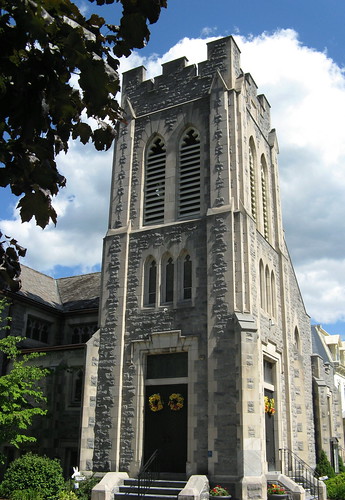
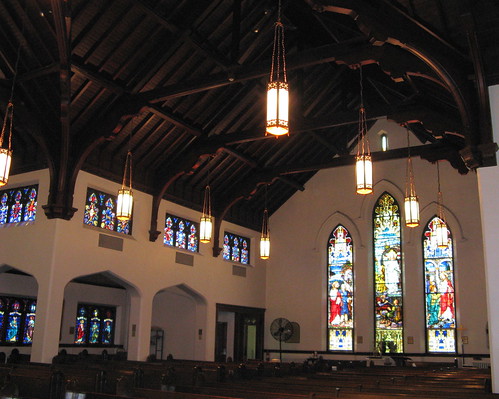

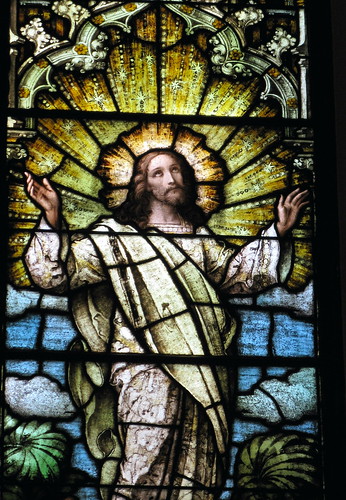
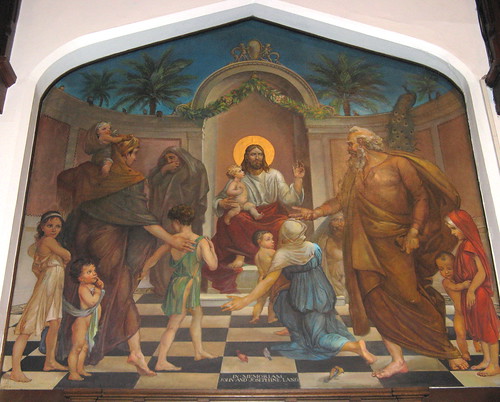
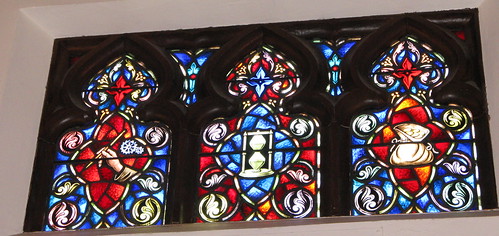




A lovely tribute to a beautiful house of worship and its admirable history. The stained glass is stunning…what skilled craftsmanship it must have taken to complete them!
Thank you for sharing a glimpse inside such a beloved church.
Ginny,
I’m happy that you feel you had a good look at this church, and indeed it feels beloved. It’s thought-provoking to consider how our buildings and homes reflect when we tend and love them well. This is such an example.
I kept wondering about the origins of the stained glass, too, and when I find out more, I’ll share it.
I appreciate your thoughtful comments!
Susan
Thank you so much for your wonderful presentation of Redeemer Lutheran in Kingston. I’ve been a member at Redeemer for 41 years, and it was so nice to read such a wonderful tribute to the church that so many of us love.
Janet,
Thank you! It’s gratifying to receive your response. Redeemer Lutheran is a special place, and I’m sure that members devote much to keep it this way year after year. It must be amazing to have been a member for 41 years!
It’s wonderful to hear that so many in the congregation love your church. May it continue to be so.
Gratefully,
Susan
Wow. That’s really excellent work!
Thanks very much! I appreciate your visit and your kind response, as always.
Susan
Hallo,
I’m Pastor Gunter Brandorff. I read about your Pastor Brandorff. Could you give me more information about him?
Greetings from Hardenberg in Holland!
Hello, Pastor Brandorff,
Wonderful to hear from you, and from Holland! I apologize that it has taken me some time to reply, but I wanted to find some information about Pastor Brandorff here. I’ve found some information and will also make a suggestion as to finding out more.
Pastor Oscar E. Brandorff accepted the call to come to Redeemer Lutheran in 1927. At that time, he was in Hillside, N.J. After accepting the call, Pastor Brandorff began his duties at this church in Kingston on Dec. 1, 1927, according to the 100th anniversary booklet Redeemer Lutheran created in 1997.
Church members greeted the pastor’s arrival with enthusiasm, and during his first year he “successfully initiated” a number of projects and placed some emphasis on activities for the church’s youth, community outreach, and foreign mission support, this booklet notes. Attendance at the church increased.
In his first year, Pastor Brandorff wrote in a summary to the church Council that, “more important than our financial success we feel was the success we have had thus far in rebuilding the good-will among our members, an achievement declared impossible by some a year ago.” Thus, it appears that Pastor Brandorff was able to help restore a positive situation after the church had endured some financial difficulties and problems that church members linked to the prior pastor, who had ended up resigning in September, 1927.
During the subsequent several years — and with the overhang of the Great Depression that proved very difficult to churches and many institutions — Redeemer Lutheran under Pastor Brandorff was able to maintain high attendance, keep strong financially, and minister to needy families, the church historical brochure reports.
In 1934, Pastor Brandorff suddenly became ill and died on Feb. 23. So he had been pastor of Redeemer from December, 1927 until February, 1934, and was apparently very beloved. I imagine that his sudden passing must have been shocking and perhaps difficult, especially after this pastor had helped the church rebound and then remain strong during tough times. One highlight of his time at the church was Redeemer’s hosting, in November, 1933, of a joint service with other area Lutheran churches marking the 450th anniversary of the birth of Martin Luther.
This booklet provides more information about Pastor Brandorff’s tenure at Redeemer Lutheran. If you provide a mailing address, I can send photocopied pages of the part pertaining to his time leading Redeemer.
Also, I would suggest that you contact Redeemer Lutheran Church, through the e-mail or phone number the church provides at its Web site:
Redeemer Lutheran Church
Redeemer Lutheran Church: Facebook Page
It is good to hear from you, and I would enjoy learning about your work in Hardenberg!
With all good wishes,
Susan
Dear Pastor,
I just came across this website for Redeemer and noticed your inquiry. I am Pastor Oscar Brandorff’s grandson. I don’t know much about my Grandfather, but please feel free to contact me about what you are interested in learning.
Regards
Rick B.
Hello, Rick,
Thanks for reaching out to the pastor. I’ll follow up via a note to him as well to help facilitate communications.
Warm regards,
Susan
Thank you, Susan!
Blessings!
Rick
Dear Rick,
I read just now your reply on the church’s site. Yes, I’m interested in your grandfather’s story and the story of the Brandorff family in the USA. Can you tell me more?
Greetings from Holland, ds. Gunter Brandorff
Hello,
I am following up with both of you.
Warm regards and blessings,
Susan
Gunter,
Greetings! Glad to hear from you. Please contact me directly at brandorff@sbcglobal.net and I will send an attachment with a bit of information.
Rick
Dear Susan, Thanks for your beautiful tribute to Redeemer. Your photos are so lovely. We have been working on our website for the church and have struggled with an exterior photo of the church without the electric wires. We would be so appreciative to be able to use your exterior photo in that website. Is there a way you would grant us permission to use it? Thanks for your work and consideration. Elke Hekler (Deacon)
Dear Elke,
Thank you so much for your comments about the essay on Redeemer Lutheran. Your church and its spiritual presence are beautiful.
I understand your point very well about seeking to render a photo without the wires. I’ll contact you sometime today, via e-mail, to discuss the photo possibility.
Wishing you a Blessed and Happy New Year!
Susan